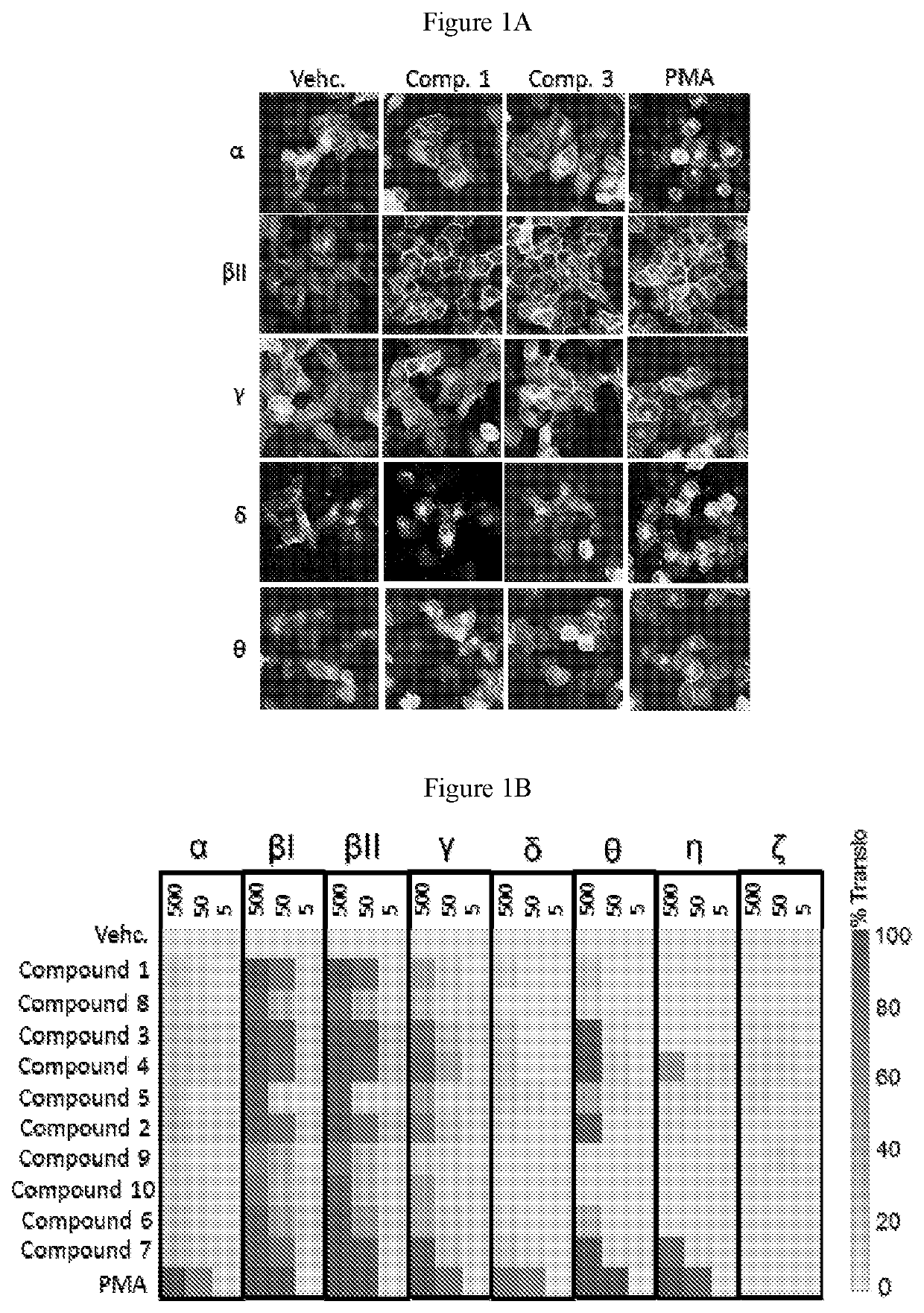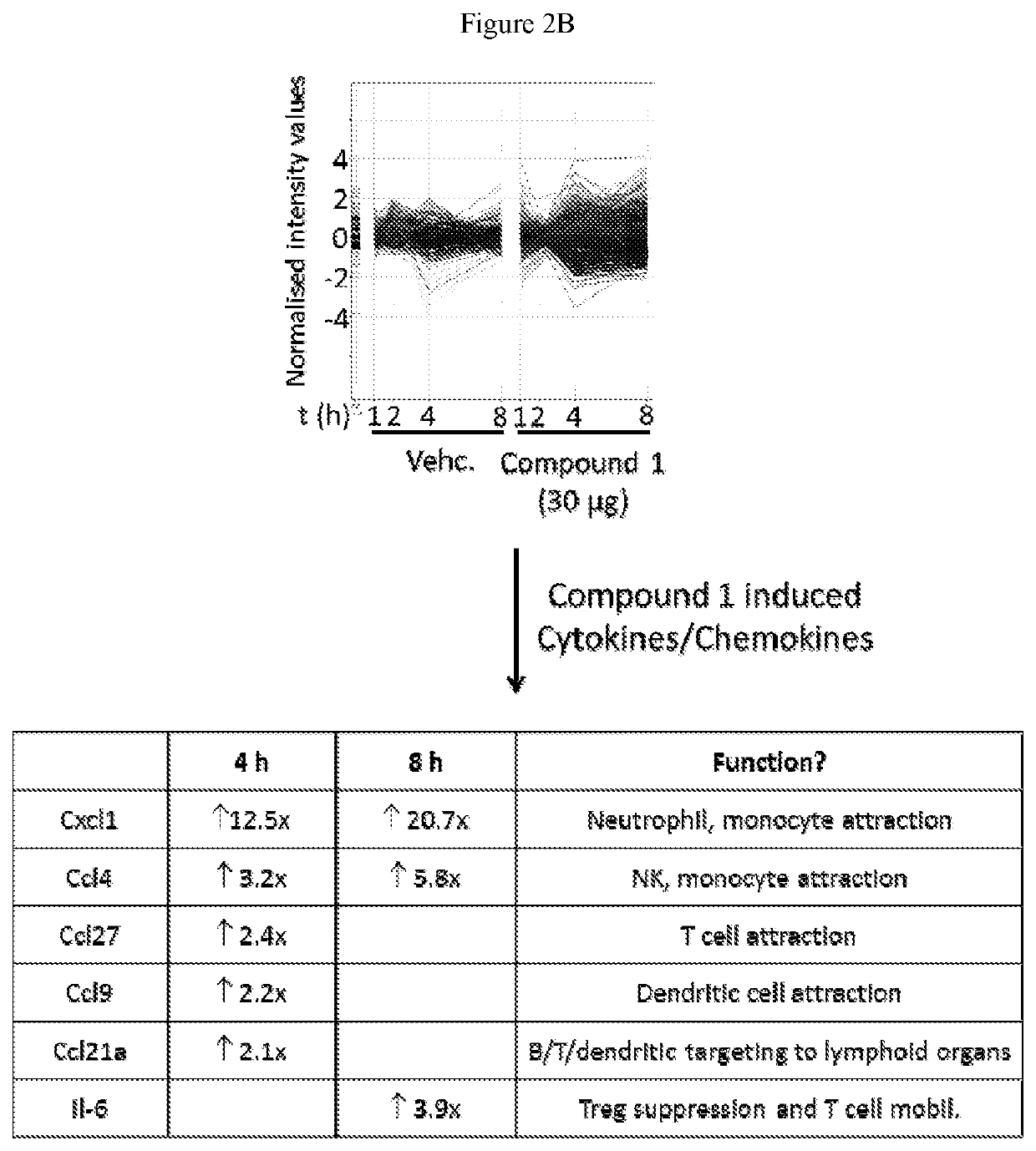Combination therapy for the treatment or prevention of tumours
a tumour and tumour technology, applied in the field of tumour tumour combination therapy, can solve the problem of limited positive response to a small proportion of the total patient population
- Summary
- Abstract
- Description
- Claims
- Application Information
AI Technical Summary
Benefits of technology
Problems solved by technology
Method used
Image
Examples
example 1
iane Analogues Activate PKC Isoforms
[0124]Protein kinase C are a family of key enzymes involved in signalling pathways that specifically phosphorylate substrates at serine / threonine residues. Phosphorylation by PKC is important in regulation a variety of cellular events such as proliferation and regulation of gene expression. PKC isoforms (-θ, -η, -α, -β, -δ, -ε) are directly implicated in immune cell responses and can also promote the expression of key immune genes. However, the expression pattern and levels of each of these PKC isoforms are cell-type and context specific (Lim et al. 2015; Anel et al. 2012; Pfeifhofer et al. 2006).
[0125]To identify specific PKC isoform activation profiles (specificity and potency) of epoxytigliane compounds, HeLa cells were transiently transfected with a selection of PKC-EGFP vectors (PKC-α, PKC-βI, PKC-βII, PKC-γ, PKC-δ, PK-Cθ, PKC-η, PKC-ζ—generated in house) using Lipofectamine 2000 (Invitrogen) following methods described in Boyle et al. 2014. ...
example 2
ession Changes in Mouse Tumour Stroma Consistent with Immune Cell Recruitment and the Induction of a Th-1 / M1-Like Anti-Tumour Immune Response
The Th1 / M-1 Like Response in Anti-Tumour Immunity.
[0129]A Th1 / M1-like immune response has been associated with induction of anti-tumour cellular immunity through a range of mechanisms including direct tumouricidal activity, modification of anti-tumour cytokine responses and potentiation of long-term immunologic memory. For example, several lines of evidence show that CD4+ T helper type 1 (Th1) cells, the drivers of Th1 immunity, can help support the clearance of tumour cells via the secretion of various cytokines, including interferon-γ (IFN-γ), interleukin-2 (IL-2), and tumor necrosis factor-α (TNF-α) (Knutson et al. 2005; DeNardo et al. 2010; Burkholder et al. 2014). These cytokines promote the activities of several cell types, including antigen presenting cells (APCs), cytotoxic T cells, NK cells, and various innate immune cell subtypes (e.g...
example 3
tion that Therapeutic Concentrations of Compound 1 and Other Epoxytiglianes Induce Cellular Oncosis
[0136]Oncosis is a form of necrotic cell death, characterised by the swelling and rupture of subcellular organelles and subsequent permeabilisation of the plasma membrane, due in part to loss of ATP-driven ion pump activity that maintains osmotic balance. Oncosis has been shown to be immunogenic in nature and is associated with the efficacy of some oncolytic viruses and small molecules developed as anti-cancer agents (e.g. Dyer et al. 2016).
Cell Lines, Reagents and Media.
[0137]A431 (human epidermoid carcinoma), MM649 (human melanoma), B16-OVA (B16-F10 mouse melanoma cell line stably transfected with chicken ovalbumin), MM415 (human melanoma) and FaDu (human hypopharyngeal carcinoma) cells were cultured in RPMI-1640, 10% FCS (complete medium) at 37° C., 5% CO2 in a humidified incubator. All cell lines used in this study were confirmed as mycoplasma negative using MycoAlert (Lonza). STR ...
PUM
| Property | Measurement | Unit |
|---|---|---|
| time | aaaaa | aaaaa |
| volume | aaaaa | aaaaa |
| volume | aaaaa | aaaaa |
Abstract
Description
Claims
Application Information
 Login to View More
Login to View More - R&D
- Intellectual Property
- Life Sciences
- Materials
- Tech Scout
- Unparalleled Data Quality
- Higher Quality Content
- 60% Fewer Hallucinations
Browse by: Latest US Patents, China's latest patents, Technical Efficacy Thesaurus, Application Domain, Technology Topic, Popular Technical Reports.
© 2025 PatSnap. All rights reserved.Legal|Privacy policy|Modern Slavery Act Transparency Statement|Sitemap|About US| Contact US: help@patsnap.com



